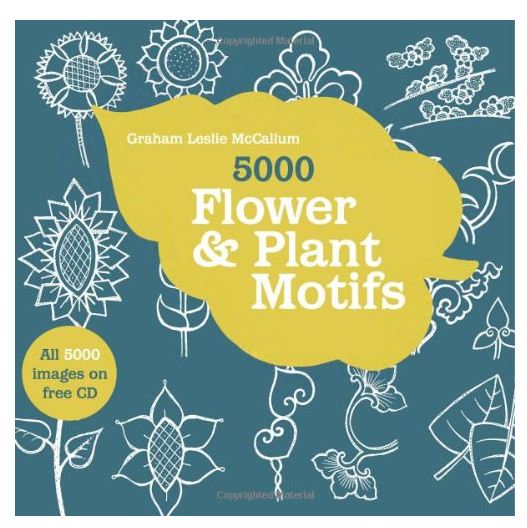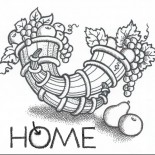Graham Leslie McCallum
The tree of happiness flowers and fruits most abundantly for the creative man
5000 Flower and Plant Motifs
 This book is a new and improved edition of the original book ‘4000 Flower and Plant Motifs’ which was published in 2004, nine years ago, by Batsford, Anova Books, London.
This book is a new and improved edition of the original book ‘4000 Flower and Plant Motifs’ which was published in 2004, nine years ago, by Batsford, Anova Books, London.
The editors at Batsford approached me to update the book, a task I accepted, as it gave me a fine opportunity to add any theme or subject I had missed on the first go. My aim was to make the new book as comprehensive as possible; a sort of plant and flower ‘Design-Bible’. I have added an extra 1000 complete motifs.
The book contains a CD with all the books contents in an electronic format. This is a super bonus as it allows the purchaser to copy, manipulate and colour the motifs as desired.
The book can be purchased at any large bookseller or on their websites. http://www.amazon.com/Flower-Motifs-Graham-Leslie-McCallum/dp/190638892X
The Contents of this book are as follows… Mesopotamian/ Egyptian/ Greek/ Romanesque/ Byzantine/ Medieval/ Islamic/ Chinese/ Japanese/ Folk/ Art Nouveau/ Art Deco/ Flowers/ Leaves/ Fruit/ Vegetables/ Nuts, Seeds and Cereals/ Trees/ Borders.
INTRODUCTION to ‘5000 FLOWER AND PLANT MOTIFS’
I have wonderful and pleasant memories of my early creative years. One of these is of me as a child at my mother’s knee, drawing pad in my one hand, and a bunch of coloured pencils in the other. Mom would give drawing lessons by example, teaching me as her mother had taught her many years before.
One of my mother’s favourite topics was to draw a typical country cottage, bedecked in rose creepers, with a path winding to its rustic door. On one side of the thatched cottage always stood a cheery apple tree in fruit, and on either side of the path, beds of colourful flowers of all kinds and descriptions. Of course, the flowers were drawn in the typical naive way accessible to all children, like lollipops, with scalloped petals and with large projecting leaves. No picture like this was left without smoke curling up from the chimney, a happy-faced sun in the sky and a few accompanying fluffy clouds. I have never stopped drawing and painting flowers, they are symbolic to me of all that is good, bright and happy. I am sure many of you would have drawn something similar as a child and can relate to these early adventures in pencil and crayon.
Such is the foundational beginnings to our creative lives; and so too the seminal nature of flowers and plants to Design. Without their contribution, our creative world would be awfully lack-lustre and colourless. Simply imagine the world without flowers and plants for a moment, and then you will appreciate the value of this collection of motifs. Indeed, the Plant Kingdom is the veritable Bread of Life to all artists, designers and hobby enthusiasts.
The importance of plants cannot be more clearly illustrated than by the ancient Mesopotamian cultures, where wheat became their staple of life, and the crop on which the Sumerians, Assyrians and Babylonians built their civilisations. It is then little wonder that the image of an ear of wheat became iconographic to these people. They decorated their pottery with this image and carved it into their clay seals. So persistent is this image that it is with us as a motif 5000 years later. One may see it today in many logos and on numerous heraldic devices.
Other plants too, such as the grapevine, and fruits like the pomegranate, have also enjoyed great longevity. They have been utilised by succeeding civilisations in turn, like the Romans and the Byzantines, as well as by following epochs like that of the Romanesque and Medieval. They have been resurrected time and again by countless artists to serve as strong and emotive design subjects. I have captured these and many other iconic motifs for your instruction, inspiration and use. No doubt they will serve the needs of the contemporary designer too.
Like you, early artists and craftsmen had an innate compulsion to ornament their handiworks and to decorate their surroundings. Looking around their environments for inspiration, no doubt their eyes would have quickly fallen on the trees that shaded their homes, the flowers that coloured their meadows, and the crops that filled their fields. Early cultures such as the Egyptians used the date palm and lotus flower in their imagery, while the Greeks used the olive tree and the acanthus for theirs. Those of you with a historical bent – may deduce interesting information about the landscape, diets and aesthetic tastes of these ancient peoples. Like our environments, this book will prove to be a ready reference to those seeking inspiration.
If one was to add up all the motifs and patterns ever created, I am absolutely certain that the vast majority of them will have flowers and plants as a subject. They vastly outnumber Abstract, Zoomorphic and Anthropomorphic imagery. As a subject source – the Plant Kingdom is the proverbial Tree of Life to designers – its branches weighted with life-giving fruit. This book harvests this incredible abundance, presenting its motifs to you in a way that will not only enrich your creativity, but also, inspire you to create your own patterns and motifs.
Within the pages of this book are well over 5000 motifs, sourced from several thousand years of our forebear’s creativity. Some will be familiar to you, having been taken from famous and well-known buildings and edifices, while other motifs are obscure, having come from objects as everyday as household pottery and fabrics. This broad spectrum of sourcing gives this collection wide appeal and functionality – allowing you to find the very motif needed to ornament your artwork.
The first chapters of this book are devoted to the imagery of nine inspirational and historic civilisations. Each chapter contains a collection of motifs that are definitive and descriptive of that culture. By using these designs and patterns – the contemporary artists can reproduce the ‘look and feel’ of those times.
The following three chapters in this book are devoted to the three most influential design styles of the modern era, namely Folk Art, Art Nouveau and Art Deco. These popular styles are well-represented with many inspirational motifs that will be a welcome addition to your motif repertoire.
The latter half of the book is reserved for motifs of my own creation. They are divided into chapters according to subject matter, such as Flowers, Leaves, Fruit, Vegetables, Fruiting Bodies, Trees and Borders. I have endeavoured to cover all the well known plants that fall within our cultural context, as well as others not so familiar.
You need not only use the motifs for source material, but also as lessons in Design. Incorporated into every motif are Art’s instructive Elements – like line, texture, shape, form, mass and movement.
All the motifs and patterns in this book are serviced by a comprehensive Index that will allow you to find the motif you are looking for with ease and speed.
I have drawn all the motifs in fine and meticulous detail so that you may extract as much information from them as is possible. They are printed in black to facilitate copying and reproduction.
Accompanying this publication is a CD that contains all the motifs and patterns within the book. This will allow you to manipulate, colour and adapt the motifs on your personal computer.
As does the seed-sower in the fields, I hope that you too will be a generous purveyor of your talents and bestow your creativity on others. I trust that 5000 Flower and Plant Motifs will find a favoured spot on your work table; that this book’s pages become well-thumbed; and that these motifs inspire you to new and creative heights.
Graham Leslie McCallum

Recent Comments